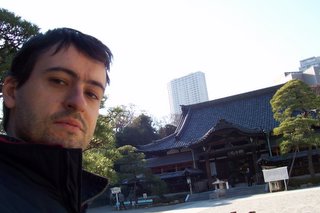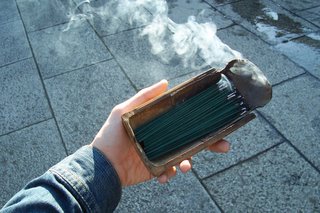
I have much to say about Tokyo. Tomorrow is my last day (hopefully temporarily) the archipelago enigmatic and seductive. When you arrive in Spain will update the blog to show you some more of the thousands (literally) pictures I've done. Wonders of digital photography. But I do not leave without having one of the stories have captivated me most.
 late seventeenth century, a feudal lord named Lord Asano had to organize a ceremony of protocol in the shogun's palace, which was something like the head of state (the emperor had a role almost anecdotal) to which sought the advice of Lord Kira. This, we think that Asano stay well with the shogun could lead to their own detriment, basely deceived him, so that the ceremony was a disgrace to Asano. Socially plunge to finish, Kira openly mocked the failure of the ceremony. Given this, Asano drew his sword and stabbed him in the forehead, which Kira's victory meant in that day, wield a weapon in the shogun's palace was a serious crime. Kira, knowing this law, was not convicted of provocation. Instead, Asano was sentenced to commit seppuku (or harakiri) and their lands confiscated and his family would be vilified for such daring. Asano was buried in the temple of Sengakuji.
late seventeenth century, a feudal lord named Lord Asano had to organize a ceremony of protocol in the shogun's palace, which was something like the head of state (the emperor had a role almost anecdotal) to which sought the advice of Lord Kira. This, we think that Asano stay well with the shogun could lead to their own detriment, basely deceived him, so that the ceremony was a disgrace to Asano. Socially plunge to finish, Kira openly mocked the failure of the ceremony. Given this, Asano drew his sword and stabbed him in the forehead, which Kira's victory meant in that day, wield a weapon in the shogun's palace was a serious crime. Kira, knowing this law, was not convicted of provocation. Instead, Asano was sentenced to commit seppuku (or harakiri) and their lands confiscated and his family would be vilified for such daring. Asano was buried in the temple of Sengakuji.  Asano's servants were, therefore, no sir. This makes, as in "Ronin" (which means just that, "raised without love"). 47 of these ronin vowed revenge against the injustice done to his master, knowing that the servant who kills a feudal lord is punished with death. So, two years later, when Kira and suspected nothing, entered his palace and killed him, decapitating him. Then they went to Sengakuji, washed his head in a hole (the one pictured above) and placed at the grave of Asano. Once done, surrendered to justice. Sentenced to death, 47 were made to commit seppuku in a collective ceremony and were buried next to his master Sengakuji. Asano's widow gave to the monks who tended the temple a plum tree that is planted next to the nearly 50 tombs.
Asano's servants were, therefore, no sir. This makes, as in "Ronin" (which means just that, "raised without love"). 47 of these ronin vowed revenge against the injustice done to his master, knowing that the servant who kills a feudal lord is punished with death. So, two years later, when Kira and suspected nothing, entered his palace and killed him, decapitating him. Then they went to Sengakuji, washed his head in a hole (the one pictured above) and placed at the grave of Asano. Once done, surrendered to justice. Sentenced to death, 47 were made to commit seppuku in a collective ceremony and were buried next to his master Sengakuji. Asano's widow gave to the monks who tended the temple a plum tree that is planted next to the nearly 50 tombs. Even today, three hundred years later, the Japanese come to Sengakuji to pay tribute to these heroes, unwavering loyalty model. There have written hundreds road works and hundreds of films on this subject.
our Fuenteovejuna Something like (which was also a real fact), but here is a matter of national pride. In Spain, however, the "Who killed the commander?" we sound like old wives' tale that are bored at the brazier. Anyway. Sic transit ...
 Sengakuji I was in a church so humble and simple, but deeply moving because of the history of the tombs, loyalty, passion with which Japanese go, silence and respect the offered to each grave lit an incense stick. I bought the incense, which they sell in large enough clusters to there are enough for each hero. For five minutes I bowed to each grave, depositing the offering. I left the room ruefully, but with some pride in the viscera.
Sengakuji I was in a church so humble and simple, but deeply moving because of the history of the tombs, loyalty, passion with which Japanese go, silence and respect the offered to each grave lit an incense stick. I bought the incense, which they sell in large enough clusters to there are enough for each hero. For five minutes I bowed to each grave, depositing the offering. I left the room ruefully, but with some pride in the viscera. Allegiance. Nobility. Justice. What a splendid life than three hundred years after his death, manages to be remembered with these three words.

0 comments:
Post a Comment